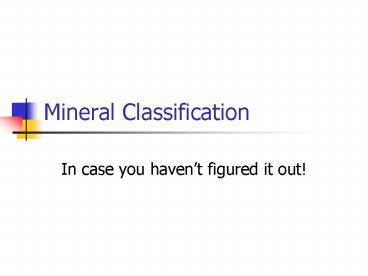Mineral Classification - PowerPoint PPT Presentation
1 / 23
Title:
Mineral Classification
Description:
Mineral Classification In case you haven t figured it out! Minerals are classified by chemical composition 1. Minerals with the same anion or anionic group have ... – PowerPoint PPT presentation
Number of Views:338
Avg rating:3.0/5.0
Title: Mineral Classification
1
Mineral Classification
- In case you havent figured it out!
2
Minerals are classified by chemical composition
- 1. Minerals with the same anion or anionic group
have unmistakable family resemblances. For
example, the carbonates resemble each other more
closely than say the minerals of Cu. - 2. They occur together in nature, for example, it
is very common to find both calcite and dolomite
in the same rocks. - 3. It agrees with the naming of inorganic
compounds in chemistry.
3
And at the next level
- Once minerals have been grouped by chemical
composition, they can be further separated into
groups on the basis of internal structure.
4
Native Elements
- Metals
- Semi Metals
- Non Metals
5
Sulfides
- Including sulfarsenides arsenides and tellurides
6
Sulfosalts
- In these minerals, As and Sb play a role more
akin to metals than anions. Many important Ag
minerals are sulfosalts.
7
Oxides
- a) simple and multiple where O combines with one
or metals (cations) - Simple
- Multiple
- b) hydroxides with OH- group and H2O molecules
8
Halides
- these minerals have Cl, Br, F, and I as anions
9
Carbonates
- Based on the carbonate radical
- Hexagonal orthorhombic and monoclinic
- You have examples of all three!
10
Nitrates
- NO3 radical
- Only 7 known minerals
11
Borates
- (BO3)-3 can form polymers--about 100 known
minerals - So are they iso, meso, or aniso desmic?
12
Phosphates
- (PO4)-3 are usually hydrous as well
13
Sulfates
- (SO4)-2 can be hydrous or anhydrous
14
Tungstates (WO4)-2
- scheelite and wolframite are both ore minerals
for W
15
Silicates (SiO4) -4
- The most important group of minerals!!
- Nesosilicates
- Sorosilicates
- Cyclosilicates
- Inosilicates
- Phyllosilicates
- Tectosilicates
16
Why can they form so many structures?
- Mesodesmic
- Remember this term?
17
Nesosilicates
18
Sorosilicates
19
Cyclosilicates
20
Inosilicates
21
Phyllosilicates
22
Tectosilicates
23
What is the best way for you to remember formulas
- General formulas!!
- Next time































